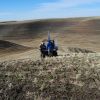Coalition on Agricultural Greenhouse Gases

Agricultural Soil Carbon in the Palouse Region
Developing an Agricultural Soil Carbon Transaction in the Palouse Region
Project Timeline: August 2011 - July 2015Applied Ecological Services, Inc (AES) and Native Energy (NE) together (AES/NE) with others are working toward a large-scale agricultural carbon restoration project that includes Shepherd’s Grain members and surrounding farmers located in the loess hills of the Palouse and Columbia Plateau region. Historic farming practices across the region have resulted in the near extinction of the native grasslands, serious soil losses, and degradation of hydrological resources.
Based on a variety of models derived from years of research along with additional sampling completed in 2009, AES/NE further developed and extrapolated models to fit a scale across the entire Columbia Plateau landscape. Utilizing a protocol under development through the American Carbon Registry, AES/NE has measured, monitored, and will have validated carbon credits stemming from carbon farming agricultural practices such as no-till, direct seeding, crop rotation, and improved soil management. This project demonstrates the role of carbon farming practices in greenhouse gas policy development as well as the importance of quantitative soil carbon methods that create compliance-grade offset credits. It also provides a roadmap for aggregating landowners across large areas at low cost. Ultimately the project could provide a model for marketing and monetizing agriculturally derived carbon credits. And, this will be one of the largest land-based carbon projects to date.
Third-party validation/verification is the core of quality assurance, and under greenhouse gas (GHG) programs such as the American Carbon Registry (ACR), Verified Carbon Standard (VCS), and other programs, all projects must be validated and all emission reductions must be verified by approved validation / verification bodies. Each program has specific specialties appropriate to its goals and objectives. For example, under the Verified Carbon Standard (VCS) program, AES/The Earth Partners, LLC (TEP) developed the first modular soil carbon quantification methodology to be validated. The methodology can be used to quantify the emission reduction and carbon sequestration benefits of projects globally. In order to be certified under the VCS, the methodology had to undergo a public review process as well as a double validation process by two separate accredited independent validators/certification bodies. Now AES/NE is using some of those modules to help achieve validation/verification for the Palouse project under the American Carbon Registry (ACR), a leading voluntary program with operational experience specializing in high quality carbon offset issuance.
Project Summary
The introduction and widespread application of sustainable carbon farming practices in the Palouse region has the potential to restore the soil quality and ensure the longevity of one of the United States’ most important breadbaskets. Demonstrating the ecological and economic value to landowners of increased soil carbon stemming from improved agricultural practices is a critical component in facilitating the large-scale adoption of such practices. To this end, this project seeks to provide a roadmap for developing large-scale, high-quality, and low-cost soil carbon transactions.
Successes & Challenges
AES/NE succeeded in enrolling and sampling soil carbon about 100,000 acres of land. More than 800 locations were sampled to a 1 meter depth. The soil sample number is sufficient to provide a statistically robust analysis of the carbon stocks on the enrolled farms. The farms included in the sampling are assumed to be statistically representative of the balance of the farms in the seven million acre project area, an assumption that will be confirmed with additional sampling as new farms enter the project.
A significant challenge has been navigating the constraints and restrictions imposed by the various GHG programs. For example, VCS has restrictions around early adopters, especially definitions of start dates that could very well exclude many of the progressive and experimental producers in the project area. Because some farmers were practicing some form of no-till farming before and after the Palouse project start date, they have been considered ineligible for inclusion and participation in carbon credit transaction through VCS. Therefore, AES/NE is working with ACR to use a performance-based protocol that accounts for improvements in soil carbon levels over time so long as the activity is eligible.
Despite this and other challenges, the Palouse project may be one of the largest, if not the largest, land-based carbon projects with private producers in the world.
Outcomes
- Scale-up the project by developing a carbon farming agricultural partnership with Shepherd’s Grain and neighboring landowners across the Palouse and larger Columbia Plateau eco-region. The project can be scaled due to the robust analytic and technical methodologies (GIS mapping, stratification, soil sampling, model projections, etc.).
- Aggregate landowners using a model whereby landowners collaborate across large acreages at a relatively low cost, a feat that is perceived by the market as a major challenge in developing cost-effective land-based carbon projects. Through relationship building with landowner, AES/NE will develop, test, and refine a low-cost aggregation model. To this end, AES/NE is building on previous experience in aggregating landowners, developing standard partnership structures, and streamlining landowner interactions and engagement.
- Model a successful land-based carbon transaction even though agricultural carbon credits cannot currently be monetized in the marketplace. This project seeks to ensure that credits derived from this project are acceptable in emerging compliance markets, as well as voluntary markets like VCS and ACR. To this end, AES/NE has developed a unique partnership of farmers, project developers, carbon investors, scientists, and government officials.
- Produce data, maps and templates to inform policy and support further research. AES/NE utilizes GIS landform and geomorphic modeling and mapping to design, evaluate, and implement regional, on-the-ground baseline analysis of soil carbon levels across the Palouse and Columbia Plateau eco-region. The data and map products represent integrated information heretofore lacking in the region, but useful for agricultural producers, government agencies, scientists, university researchers, and others.
Project Partners
- Applied Ecological Services
Brodhead, WI
- NativeEnergy
Burlington, VT
- Shepherd's Grain
Portland, OR
©2015 Coalition on Agricultural Greenhouse Gases (C-AGG). All rights reserved.


Post a comment